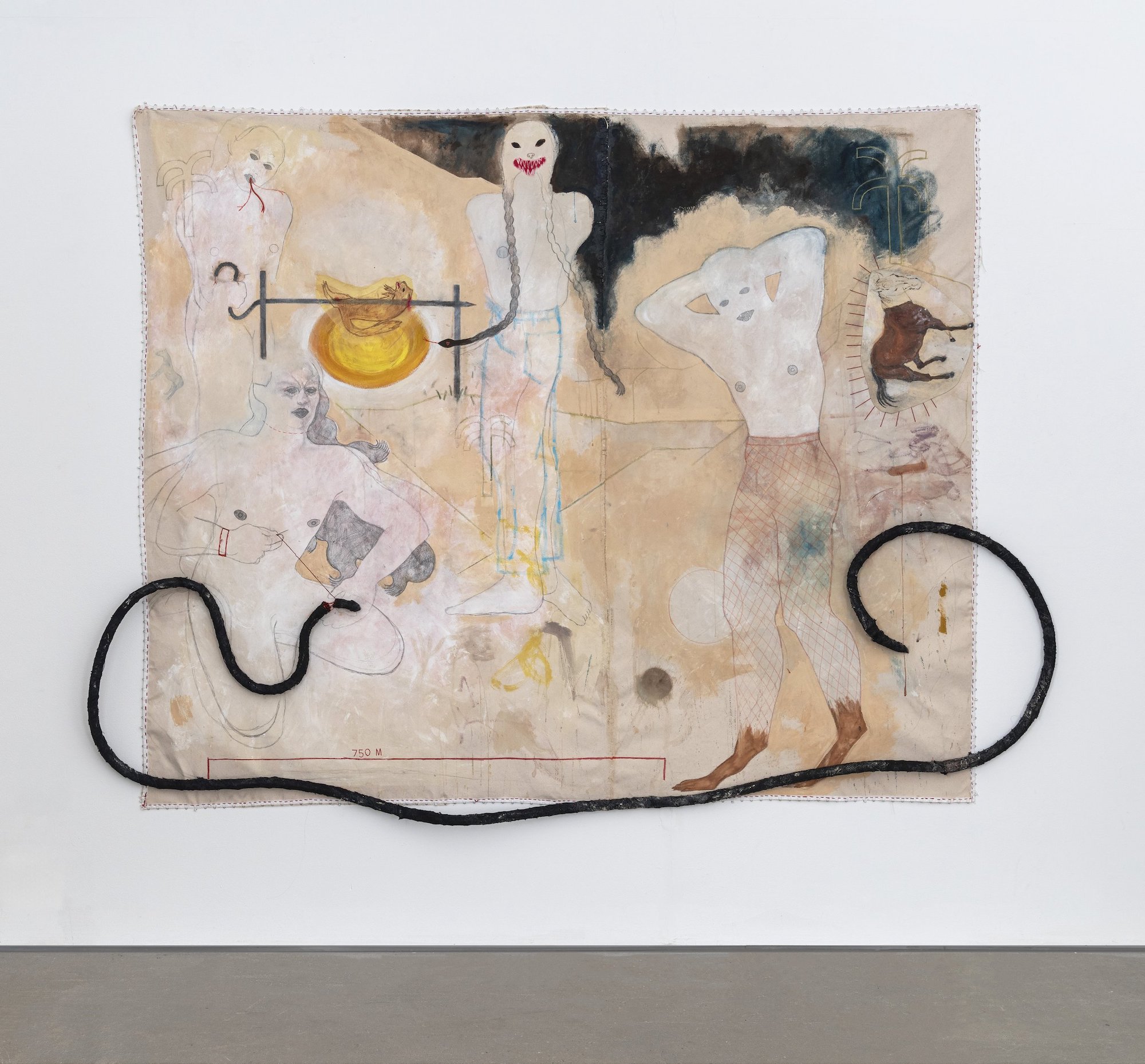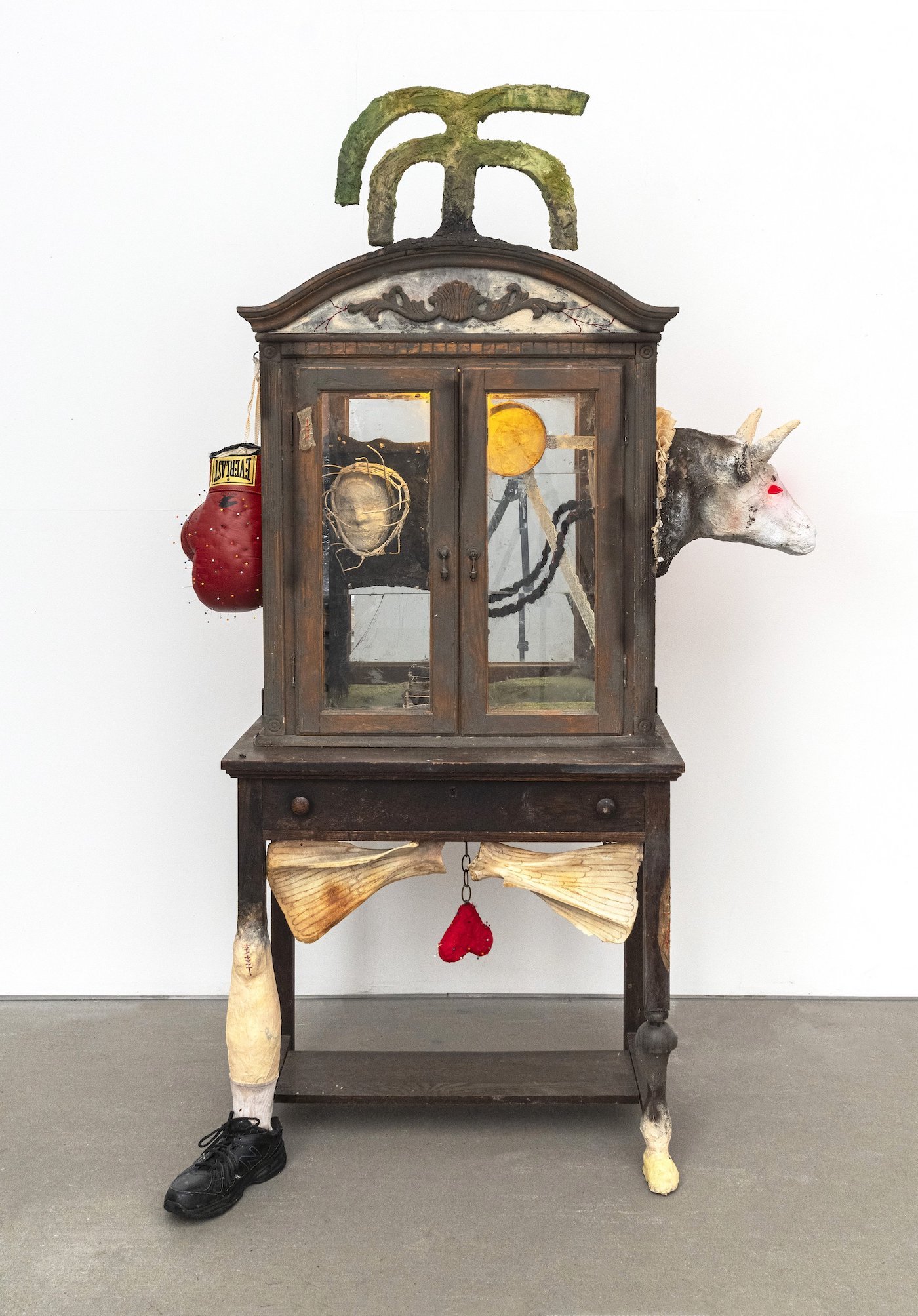“The Outline of Her Words”: Where Myth Meets Memory
Walking into Swivel Gallery at 350 Hudson Street, one might imagine stepping into a long-lost childhood home. The partition walls are marked by torn wallpaper, exposed wooden supports, and haphazard patches of paint. There are faded couches and chairs that ask you to stay awhile, a mantlepiece adorned with clocks and angel figurines, and a credenza displaying family photos alongside a TV that plays what appears to be an old Soviet program. One passes through the lived-in rooms like an amnesiac floating through a strange dream, trying to remember.
Amy Bravo’s TransmogrificationNOW! features a series of multimedia paintings and sculptures that evoke the artist’s Cuban-Italian heritage while constructing a new sense of home and identity. Bravo’s work is characterized by a hodgepodge of found objects, which merge with narrative paintings and sculptural forms to create pieces heavy with personal meaning and mystical symbolism. Bulls, roosters, and spiders are recurring motifs throughout the show, inspired by the mythology that informs Bravo’s practice, speaking to the influence of Louise Bourgeois and Kiki Smith. A text by Mallory Pearson, which accompanies the exhibition, reads, “the weaver says i won’t leave you and doesn’t feel bad for lying. the bull can only hear the outline of her words, flat and soundless as a pencil to the page. she’s carrying the rooster wrapped in silk, half-blind, demented by time, so shriveled that he’s light as a fly.” Simultaneously poetic and raw, Bravo’s zoological references weave together a personal and cultural history that resists easy interpretation.
A tower of battered cardboard moving boxes are stacked in one corner of the gallery, labeled “bedroom,” “bathroom,” and “hall closet.” A sewing machine sits on the floor next to them among cans of paint and an old lampshade. From an open box atop the tower, a spider’s hairy legs emerge. There is history in the walls of the house, stories hidden within each keepsake and tchotchke. Bravo becomes the spider who weaves these stories together, tracing themes and parallels across objects, across borders, and across myths and memories to construct a narrative that is uniquely her own.
The spider’s influence is legible throughout most of the exhibition, not only in the pieces themselves, but also in the large crocheted webs that hang overhead, marking echoes of the artist’s presence. In pieces like The 750 Mile Snake, the weaver is represented within the piece itself: a painted figure holds a needle, whose red thread is not merely a painted line but pierces the canvas, joining together the dismembered head of the snake. In Silk Tosser, the spider’s web repairs a hole in the figure’s own center, each thread held taut by six outstretched arms. The piece’s raw edges, holes, and lace inserts emphasize the process of repair and placemaking central to the weaver’s mythology and mission.
In conversation with Interview Magazine, Bravo describes spiders as “a little thing that’s dangerous but also crushable. It sustains itself with its craft, and it makes its home wherever it is, and it uses what’s around it to weave a world.” Likening her role to that of the weaver, Bravo describes how “I was using my resources to create something that allowed me to be much stronger than I physically was. It’s like the web of artwork, the storytelling of artwork, is a tool that allows me as the little spider walking around on it to be stronger, to take bigger strides, to collect things, to kill things that need to be killed, and to sustain myself.”
In Automaton 3.0 (Bull), the same red thread visible in The 750 Mile Snake is wound around a wheel, holding a heart suspended in what was once a wooden towel rack. The heart is shielded by real ribs, and the sculpture’s representation of an animal form is cemented on one end by a tail of dried twigs, and on the other a face framed by braids and two horns of drooping candles Nearby, a more realistic bull’s head emerges from the side of a curio cabinet that serves as the base for Automaton 4.0 (Bull-Remastered). On the other side of the sculpture, a pair of boxing gloves stuck with sewing pins allude again to the weaver’s presence. In Automaton 6.0 (LIKE A NIGHT MOVER), the weaver wears boxing gloves to indicate her struggle has been won, having captured the reappearing rooster in a woven net.
The intricacies of these pieces reveal themselves the more viewers sit with them, encouraging visitors to circle the room again and again, searching for hidden clues and synchronicities like flipping through an unlabeled album of family photos, or picking apart a cabinet of keepsakes.
Bravo not only evokes the physical and emotional placemaking undertaken by immigrants and those in diaspora, but also re-creates the experience of wandering through fragments of memories and piecing history together as a detective and as an author. Viewers are invited to mimic Bravo’s process, to weave the fragments into something legible, and to stitch together the corners of the heart with threads of their own emotional histories and inherited narratives. Through immersive theatrical staging, Bravo thoughtfully blends historic family relics with inventive creations to convey an unmistakable reverence, paying homage to the alchemical process of interpreting stories through a diasporic lens.
Amy Bravo: TransmogrificationNOW! is on view at Swivel Gallery from Sept 7th to Oct 7th, 2024.





